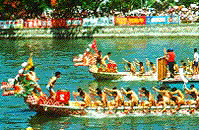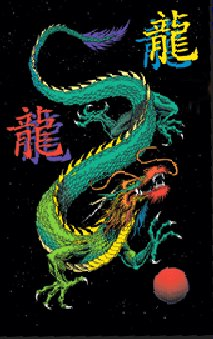The
Chinese Dragon Boat Festival
The Dragon Boat Festival is a lunar holiday, occurring on
the fifth day of the fifth lunar month
 The Chinese Dragon Boat Festival is a significant
holiday celebrated in China, and the one with the longest history. The Dragon
Boat Festival is celebrated by boat races in the shape of dragons. Competing
teams row their boats forward to a drumbeat racing to reach the finish end
first.
The Chinese Dragon Boat Festival is a significant
holiday celebrated in China, and the one with the longest history. The Dragon
Boat Festival is celebrated by boat races in the shape of dragons. Competing
teams row their boats forward to a drumbeat racing to reach the finish end
first.
The boat races during the Dragon Boat Festival are traditional
customs to attempts to rescue the patriotic poet Chu Yuan. Chu Yuan drowned
on the fifth day of the fifth lunar month in 277 B.C. Chinese citizens now throw
bamboo leaves filled with cooked rice into the water. Therefore the fish could
eat the rice rather than the hero poet. This later on turned into the custom
of eating tzungtzu and rice dumplings.
The celebration's is a time for protection from evil and disease
for the rest of the year. It is done so by different practices such as hanging
healthy herbs on the front door, drinking nutritious concoctions, and displaying
portraits of evil's nemesis, Chung Kuei. If one manages to stand an egg on it's
end at exactly 12:00 noon, the following year will be a lucky one.
History
The Dragon Boat Festival
is one of the most spectacular traditions of ancient China. It is an exciting
period for rowing competitions marked by the eating of rice dumpling called
"Ma Chang". In some Chinese-speaking societies, the day is also known as the
"Poets' Day".
The Legend behind the Dragon Boat Festival embodies the story of love and service
for one's country. About 2300 years ago, during the Warring States period, a well-respected
poet and statesmen named "Qu Yuan" lived in the Chinese Kingdom of Chu
and served the government with integrity as Minister of State. He was disturbed
by the corruption and by the court intrigues of many courtiers who resented his
talent, popularity and sense of righteousness. One version said that other officials
convinced the Emperor that Qu Yuan was corrupt, that his plea for reforms be ignored
and had him banished from the Kingdom.
For years, he wandered the countryside composing poems expressing his patriotism
and love for the people. Either as an act of despair or an ultimate protest
against the corrupt government, Qu Yuan threw himself into the Mei Lo river
(in today's Hunan province) on the fifth day of the fifth month in the year
278 B.C. Qu Yuan opted to commit suicide rather than lose face and honour by
serving a corrupt government.
He composed two famous poems known as "Ai Ying" and "Huai Sha"
before jumping into the river with a large stone tied to himself. Grief-stricken
local fishermen who witnessed Qu Yuan's desperate act, tried to save the patriotic
poet. They sailed up and down the river to look for him and desperately thrashed
the water with their oars and paddles to scare off the hungry fishes which might
eat his body. To commemorate the patriotic man, the fishermen and rural town
folks threw cooked rice dumplings wrapped in silk or banana leaves, into the
water in order to appease the spirits of the river on his death anniversary.
These rice dumplings are called "Tsung Tze" or "Ma Chang".
The first Dragon Boat Races were recorded in the Tsin period. It became popular
in the Tang Dynasty ( 618-907 A.D.) spreading throughout the Yangtze River Valley
and to most of South China. One paddler traditionally stands in the boat searching
for Qu Yuan's body while a drummer on board and the ferocious-looking dragon
designs were added to frighten away evil water spirits. This is because Chinese
people traditionally regarded the dragons as presiding over the water and having
dominion over rainfall. It is also the supreme symbol of power and benevolence
in the Far East. In the present day, the Dragon Boat Festival is held annually
in different nations world wide. In China alone, 20 million people are active
in this sport which is organised in the various cities and provinces. In a young
country like Singapore, we are already celebrating 22 years of Dragon Boat activities.
TRADITIONAL RITES ASSOCIATED WITH DRAGON BOAT RACING

The ritual aspect of dragon boat racing has a deep cultural
heritage and springs from religious beliefs. The colourful and traditional rites
are preformed on the dragon boats before and after the races. They reflect deep
reverence for the vessels despite certain degrees of variation in the procedures
followed by the believers.
There are basically two important ceremonies which have to be performed for
the dragon boats. They have to be blessed and "awakened" before
the races and then properly induced to "repose" afterwards. Four
days before the festival, the dragon boats are taken out of their storage
yard and their dragon heads and dragon tails are attached to them. A benediction
ritual done with great pomp and ceremony follows this and involves the burning
of paper bills in front of the dragon boats, the making of offerings and chanting
of prayers to heavenly gods. This ritual serves to ward off evil and to sanctify
and bless the dragon boats. In addition, this action is supposed to make the
dragon boats strong and fierce and therefore fit to compete in the exciting
races.
When this has been done, each dragon boat is rowed out to sea, on a course
perpendicular to the nearby temple and then back to the temple with the drummer
beating the drum. This procedure is repeated three times. The performance
of these rituals and the staging of dragon boats races show a community's
dedication to its gods. In return, the members of the community will be protected
from unfriendly spirits of the sea and blessed with happiness and prosperity.
"Life" is given to a
newly-built dragon boat at a ceremony performed by a Taoist priest a few days
before the actual festival. Holding a bell and a sword into the "Fu Zhou" (a
paper bill with "magic" words) while chanting some "magic" words, he then
touches the dragon head, tail and drum with the sword, following which paper
money is burnt and "magic" sand is sprinkled on the dragon head. A community
leader is invited to dot the eye of the dragon head and, afterwards, the
dragon's eyes will be drawn in red with a brush.
When the races are
over, the dragon head, tail and drum are removed from each dragon boat and
stored either in the temple or in another place agreed upon by the community.
Incense is burnt to thank the heavenly gods. Meanwhile, the body of a dragon
boat itself is usually covered with sand along the shore near a temple or put
on appropriate racks and covered with roof-shape tin foil covers. By
performing these basic procedures, the dragon boats are considered to be
properly induced to "repose" until the next Dragon Boat Festival when the
whole cycle of ceremonial rites will be repeated.
 The Chinese Dragon Boat Festival is a significant
holiday celebrated in China, and the one with the longest history. The Dragon
Boat Festival is celebrated by boat races in the shape of dragons. Competing
teams row their boats forward to a drumbeat racing to reach the finish end
first.
The Chinese Dragon Boat Festival is a significant
holiday celebrated in China, and the one with the longest history. The Dragon
Boat Festival is celebrated by boat races in the shape of dragons. Competing
teams row their boats forward to a drumbeat racing to reach the finish end
first. 